Shaking the Family Tree: My Journey of Recovery, Repair and Renovation
Share
Breaking News!
Today's news and culture by Black and other reporters in the Black and mainstream media.
Ways to Support ABHM?
Scholar-Griot: Warren Read, Author
The Lyncher in Me: A Search for Redemption in the Face of History
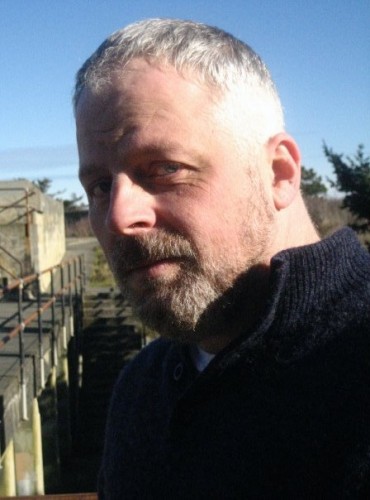
Warren Read, a public school teacher in the State of Washington, discovered that his beloved great-grandfather took an active part in the lynching of three young black men in Duluth, Minnesota. He embarks on a journey of atonement and redemption.
I have a distinct memory of a backyard, not my own, and a large dug hole with mounds of dirt piled all around. I’m with a friend and her mother is yelling at us, hysterical. “What have you done?” she’s screaming. “We’re digging to China,” my friend says. We never got there, the only thing we found in our search was more dirt.
It’s an amusing memory, but one that also gives me a pang of discomfort when I think of it, especially since I’m a parent now, and I have a garden that I enjoy quite a bit. The thought of one of my children digging a bathtub-sized hole in the middle of it makes me feel a bit anxious as well. Memories of childhood do that. They bring smiles and tears, and elation, and nausea. We find strands that connect them to ourselves today, and the branches of our family tree become much more connected in turn.
The last time I recall having had any interest whatsoever in researching my family history was when I was in the fourth grade. We’d been assigned the all-too-familiar “chart your family tree” assignment and I was forced to sit down with my parents and ask for the names of my ancestors. Together, we were able to plot names as far back as my great-grandparents, with one “great-great.” It was a short activity and an even shorter tree.
For one reason or another, it never occurred to any of us at the time to actually phone my grandparents and research further. Perhaps I’d begun just ten minutes before my bedtime; maybe my father was in another of his cranky moods. At any rate, a couple of twigs got labeled and I was finished with the assignment.
By the time I was seventeen, three of my four grandparents had passed. Five years later, my father’s father died and it would be another eleven years before I was infused with the curiosity to look behind my present generational information.
The reasons for this are less interesting than the reasons I hadn’t looked before. While I had occasionally wondered about my ancestry, the people who could have given me the greatest wealth of information were no longer available. By the time the wonders of the Internet began opening this up for many people, I had lost much of the desire to research at all. I had been estranged from my father for many years; the reason being that I was pretty confident that the only things I’d dredge up on my namesake’s side would be further examples of how the cycle of dysfunction had continued through him. I honestly felt that any justifications for his malformed character had no resonance for me.
In addition, by this time my partner Shayne and I had adopted our son Dmitry. Given the emphasis on “bloodlines” in genealogy, I had a difficult time finding the pertinence and usefulness any longer of a family tree for my family. Genealogy was all the rage. It seemed like every friend I had was trying to charcoal rub the far-reaching generations of his or her ancestors. I had no interest—not for me, not for my son. What possible interest, I wondered, could Dmitry have in the biological history of his adoptive father? Given the magnitude of my love for this child, with whom I shared zero strands of DNA, and the significant absence of similar feelings toward the man who contributed to my initial creation—what purpose would a genealogical search serve? In the end, a chance conversation with an aunt piqued enough curiosity that I began a half-hearted attempt at some semblance of a family tree. It began as whimsy, but quickly metamorphosed into the unraveling of a deeply complicated puzzle—with a disturbing, surprising twist contained within.
As my research had spread to my maternal side, I discovered a mounting frustration with the lack of information out there. Night after night, I alternated my searches for “the Foys of Mississippi” (my mother’s mother) and “the Dondinos of Minnesota.” (my mother’s father). While my data entries turned up plenty of Foys in the deep south, I never was able to make the correct connections I needed. I tabled these and moved to the other side.
The muddled search for my mother’s father’s family was even more astounding and frustrating. One would imagine that with a name like “Dondino” it would be quite simple to isolate specific information. However, while I found references to grave sites of those who appeared to be great uncles and aunts, I still found absolutely no mention of my great grandfather, Louis.
I had been spending from four to six hours a week on this quest, and was quickly finding myself stuck in an endless roundabout. I had made the determination that whatever was out there, I had already found.
One night, I tried a search engine I hadn’t used before, entering simply, “Dondino, Minnesota.” Suddenly, I found myself looking at a series of links that were completely new and unfamiliar to me.
Puzzled, I could tell at a glance that each was a reference to a lynching occurrence in Duluth, Minnesota at some time. I took the first link to an article entitled “Duluth’s Lingering Shame,” which chronicled the night of June 15, 1920, in which three young black men had been dragged from their cells in the town jail, and lynched from a nearby streetlamp by a vigilante mob.
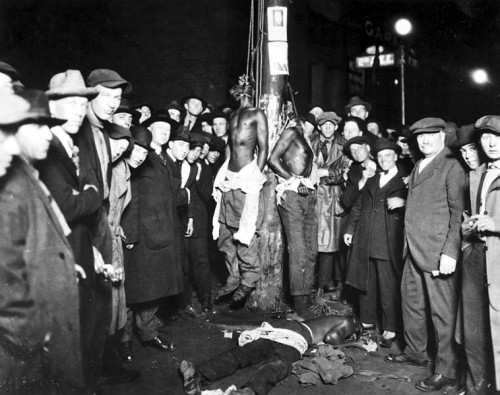
This is a souvenir postcard from Duluth, Minnesota, showing the lynchings of young circus workers – Elias Clayton, Elmer Jackson and Isaac McGhie – on June 15, 1920. Such photos, along with body parts and clothing, were commonly collected memorabilia during the Jim Crow Era.
The story went on to explain the background of the event: A young couple, not beyond their teens, had come to police to report an assault on the woman of the pair. They’d claimed that, while visiting a traveling carnival nearby, three of the workers there had attacked and raped the young woman. Police responded by bringing the young man with them as they stopped the train of departing workers. They ordered all of the black male passengers from the train and commanded the young man to identify the assailants. When he began to falter and show a reluctance to identify any offender, the officers encouraged him to “pick ones that look like they might have been around the same height and build.” By the end of the night, six men were brought to jail—three as suspects, three as potential witnesses.
These details, as well as the fact that a doctor’s examination showed no evidence of any assault whatsoever, were unknown to the mob of 5-10,000 Duluth citizens who eventually showed up at the jail the following night. Members of the mob overtook the guards, broke into the jail, smashing through brick walls, and dragged three of the young men from their cells as they screamed and proclaimed their innocence. One by one, they were hanged by a rope from a nearby streetlamp and, in a final act of humiliation, photographed while surrounded by dozens of smiling, proud white faces. This image would later be sold as a “postcard,” as was amazingly common at the time.
What really happened the previous evening will likely never be known, but the fact that three innocent men were killed for a crime that didn’t exist is well-documented. No one was ever convicted for the hangings, though three men were eventually convicted of helping to incite the riots. One man, a 39 year-old single father named Louis Dondino, was mentioned rather prominently in the story. One of the few men in town with a motor vehicle, Louis did transfer work for the city with his pickup truck. That night, he apparently used his truck as a vehicle for carrying rabble-rousers from the west end of Duluth to the jail downtown.
Needless to say, my mind was spinning. Could this be the same Louis Dondino—the man to whom my mother affectionately referred as “Pa”? The absurdity of the question hit me almost as soon I formed it. Of course it was. The age was right on, certainly the location was indisputable. And then there was the name. After months of searching and finding no information, no context in which this name appeared, then suddenly here it is—did I really believe that there could have been another Louis Dondino in Minnesota at the same time and same age?
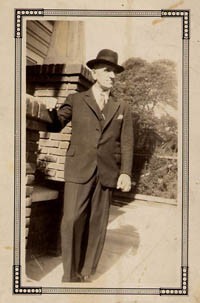
My great-grandfather Louis Dondino, circa 1955.
Instantly, my mother’s face flashed through my mind, as did the gummy grin of her grandfather, his rumpled fedora dipped over his dark eyes. My gut churned, and my heart felt like it was fighting to burst from my chest. Looking back, it was as though I had been looking at a framed family photo my entire life, and now, suddenly, I had discovered a crack, right down the middle. And through that crack appeared the tiniest images of a completely different world—a world that not one of us knew a single thing about.
I continued to read article after article, well into the late hours of the night, absorbing as much detail as I could, knowing that when I broke the news to my mother, I would have to have as few loose ends as possible in order for her to begin processing it.
Along the road of my own spiritual quest, I’ve found that discovering new concepts and taking on new beliefs can be as exhilarating as letting go of old ones can be difficult. As a youngster, the ideas that I had of “eternal life” were often very comforting when struggling with issues of my own (and others’) mortality. Death is a gentler conclusion when accompanied by the vision of spending eternity sitting on a cloud, sharing my harp with my favorite family members and friends. But over time, that picture became less vivid for me and I came to believe that the concept of “eternal life” had to mean something less ethereal.
Here is what I imagined: If a person’s legacy is that thing which “lives on” long after his or her physical self has returned to the earth from whence it came, then in some sense, cultivating and recognizing a legacy could be one way of stretching our existence beyond our physical one. Through the memories and stories passed from my mother to me, my great-grandfather had always lived on though his legacy as a man of enduring love, kindness and—ironically—racial tolerance. (One of the most oft-told stories was that of Louis and one of his best friends, Bill, the only black man in the small town in which my mother grew up.) But now the edges of this image were becoming curled and faded. It was clear to me that the picture to which I’d grown accustomed was not fully developed. What had once been a sense of admiration and warmth toward my great-grandfather was quickly becoming layered with a film of anger and disgust. I was ashamed—of him, of myself, and my entire family name. I felt myself wishing I had never searched, or that I could wipe the name clean from history.
 I had laid the groundwork for my mother over the phone. I told her I’d found out that her grandfather had done some time in prison, involving a mob lynching of three men, when her father was a young boy. I had a good many details to show her. When we finally met, she took it in with a surprising level of strength. In fact, I was surprised at my her overall response—at the lack of emotion and seemingly defensive way in which she took it in, almost minimizing the event by putting it in the context of “another time and place.” I wanted to shout, “Are you kidding me? The man was a monster!” But in the end I realized she was processing feelings that I couldn’t begin to share. This was a man she loved dearly, who had often been a safe harbor in the storm that was her young childhood.
I had laid the groundwork for my mother over the phone. I told her I’d found out that her grandfather had done some time in prison, involving a mob lynching of three men, when her father was a young boy. I had a good many details to show her. When we finally met, she took it in with a surprising level of strength. In fact, I was surprised at my her overall response—at the lack of emotion and seemingly defensive way in which she took it in, almost minimizing the event by putting it in the context of “another time and place.” I wanted to shout, “Are you kidding me? The man was a monster!” But in the end I realized she was processing feelings that I couldn’t begin to share. This was a man she loved dearly, who had often been a safe harbor in the storm that was her young childhood.
That night, however, I made a crucial decision on my own. In my readings of the lynchings, I’d come across several mentions of a committee and the work they were doing to create and install a memorial to the three victims. I knew, without a doubt, that I had to contact the committee and offer whatever support I could to help them in their endeavor.
I’m a public schoolteacher, and one of the science topics with which my fourth grade students must grapple is a basic chemistry unit—the final lessons dealing with the concept of PH. Far from being an expert, I always struggle to explain the complexities of the PH scale, what it means, what “PH” really stands for. What I do know and share with my students is that the PH scale runs from 1 to 14, the lower numbers increasing in acidity, the higher numbers increasing in alkalinity. Either end of the scale can be caustic to humans and restricts the forms of life that can survive in that environment. Basically, most plants and animals can exist in an environment whose PH is between 6 and 9. Those of us who garden or keep fish (or a hot tub) know that the slightest things can set the level off balance and we then need to take measures to bring the environment back into balance.
As part of the learning, I do an experiment with my students in which I add some indicator to tap water; they marvel at the sudden blue that overtakes the water. Then I take a small straw and begin blowing into the water and what they then get to see is that the water soon turns to a bright yellow. The lesson being that carbon dioxide gas, coupled with water, creates an acidic solution. We then go on to discuss other aspects of ourselves that fall on one end of the scale or another—namely the gastric juices in our stomachs. Students are impressed to know that their stomachs are able to withstand a substance that falls below two on the scale.
Much like life in general, I’ve long believed that it’s crucial as a temporary resident of this earth to help facilitate that balance that will best ensure the optimum conditions for healthy life. When we take from the earth, we upset the balance and have a responsibility to give something back. When we say a hurtful thing to another person, we recognize that we have upset the balance in that person’s life and it is upon our shoulders to try and facilitate a move back to the center.
Anger and stress over the conditions around us churn the stomach, kick in those gastric juices and the balance is offset. We can seek to level it out with meditation, problem solving or maybe just by chewing on a Tums.
We become frustrated at a coworker, our partner, our kids, the person in the lane next to us and we exhale words that turn a calm, blue moment to an acidic, sharp yellow. We know that it’s in our hands to “oxygenate” things, bring it back to the blue.

In the 1990s, community members began holding vigils on the site of the lynching. A plan evolved to mount a historical plaque there. At the time, school books in Duluth made no mention of the murders. As a grassroots committee worked on the commemorative plaque idea, a vacant lot across the street became available for development and the idea of a memorial plaza was born. The community raised $150,000 and the Memorial was dedicated in October 2003. Some 3000 people attended the dedication. I was invited to be a keynote speaker.
Unbeknownst to us, my great-grandfather’s legacy was out of balance—both in our minds and in the minds of those who knew of the lynchings. Our own realities sat on opposite ends of the scale. In Duluth, the name “Louis Dondino” brought images of racism, instigation and hysteria-inciting. In our family, the same name conjured feelings of love, gentleness and affection. Our Louis was on a pedestal; theirs was a footnote in a tragic story.
So as I put together the pieces of this story, fitting them into my own life, I recognized that on that night in Duluth, a huge withdrawal had been made from humanity that had greatly thrown it off balance—so much so that the community in which it had happened was still struggling, over 80 years later, to bring things back to the center. Only an equally powerful, positive event would do this. I knew without a doubt that I had a responsibility as a member of the “human family” to do what I could to weigh down that scale.
Webster’s defines a “tribe” as “a system of social organization comprising several local villages, bands, lineages, or other groups and sharing a common ancestry, culture, language and name.” Each of us can claim membership to a tribe of some kind, whether it be our home or extended family, our place of work, a club or interest group to which we belong, a minority (or majority) group with which we identify or even a common experience—glorious or tragic—that links us with others.
The group putting the memorial together shared membership in a tribe of concerned and feeling citizens, committed to honoring a group of victims and facilitating healthy, open dialogue about race relations and historical violence in their community. I had the distinction of being able to include myself in a much smaller tribe—a tribe of families directly linked to the lynching. And by this measure, I was in the unique position of giving a more direct and meaningful element to the process.
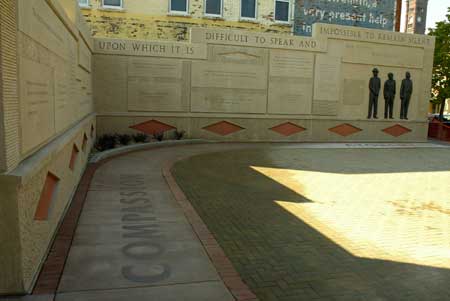
The Clayton Jackson McGhie Memorial plaza in Duluth, Minnesota.
So in October of 2003, I attended the unveiling of the incredibly beautiful and moving memorial in Duluth, having been invited as a keynote speaker. As I stood before the amazing monument (a life-sized bronze relief of three young, black men, surrounded by various engravings extolling tolerance and forgiveness) I faced an audience of over 2,000 people. I shared my mother’s memories of her grandfather, hoping to illustrate that whatever it was that had led him to the horrific acts that night did not continue in a cycle. I shared the story of Louis’ African American friend Bill, and an incident in which he and my grandfather Ray stood up for the man in a moment of tension involving other tavern-goers. I talked about the message of tolerance and respect that had been passed down from grandfather to daughter, and from her to me. I also reiterated the need to view the knowledge of that night, and the memorial, not with shame, but as an opportunity to teach and learn. That only a failure to recognize and learn from what happens should warrant shame.
But there was more that needed to be said, more I needed to give from my family.
Crafting and presenting an apology is to provide repair and renovation. While there is certainly a wealth of injuries that cannot be remedied just by saying “sorry,” there are those that may only be repaired by an apology. This is the power of a sincere apology—one given without justification or qualifier. It is the reparative mechanism available when relations have encountered something that can be neither fixed nor ignored.
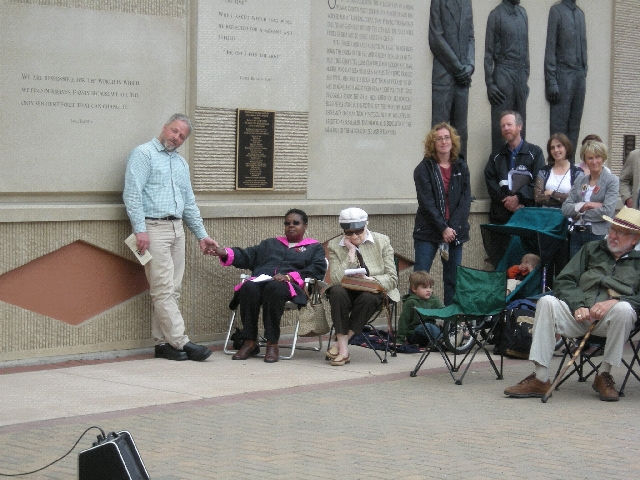
I'm holding hands with Virginia Huston, a descendant of Elmer Jackson. She was the first representative of the lynching victims to be at the memorial.
Dr. Aaron Lazare, author of the book On Apology has written, "What makes an apology work is the exchange of shame and power between the offender and the offended." Through this, a balance of power is achieved, in that the powerful offer their vulnerability, while the humiliated are empowered.
And so I apologized to the three men—Elmer Jackson, Elias Clayton and Issac McGhie— specifically and sincerely. Each man was given his own statement of atonement and unequivocal regret on behalf of my family. As a member of my its tribe and the larger tribe of the descendants of the mob that night, I placed the responsibility for shifting that power—and thus facilitating balance—onto myself. Judging from the reaction of the crowd and conversations I had with several members afterward, feelings in Duluth moved a little closer to “blue” that day.
It’s a given that when digging into the unknown, one runs the risk of uncovering something surprising. It may be unsightly, smelly, or at the minimum, really uncomfortable. Your first impulse may be to bury it and walk away, pretending you never found it. But you did, and it won’t go away just by ignoring it. In fact, it’s now a lot closer to the surface that it was before and it’s only going to get uglier, smellier and more uncomfortable. In the classroom, this is called a “teachable moment”—a priceless opportunity to use the surprise results as a learning tool.

Don Clariette, another member of Elmer Jackson’s family, and I.
The challenge we each must face is that of seeking ways in which we might welcome surprises and use them to facilitate balance in our world, to take on the task of bearing the responsibility that comes with the advantages of membership in our own tribes and discover the mutual rewards that come with it.
In the end, my mother and I accepted and appreciated this new, complicated picture of her grandfather. I was able, through a series of events that I can only classify as “miraculous,” connect and forge friendships with the descendants of one of the lynched men—Elmer Jackson. The rewards that came from this whole experience have been far reaching. The community of Duluth gained another tool to facilitate deeper learning; my own family has cleared away much of the brambles that had obscured the path that led to our present lives. We learned that it’s all right—in fact, it’s imperative—to take the uncomfortable things that everyone else has jumped over and scrape back the soil. Study it, however unpleasant it might be. Embrace it, even. Sometimes treasure comes in unexpected forms.
Warren Read is a 4th grade teacher who lives in Kingston, Washington with his partner Shayne their three sons, ages 14, 17 and 20. Warren is currently working on his Master of Fine Arts in creative writing; in 2008 his memoir, The Lyncher in Me, was released through Borealis Books. He is currently working on a novel.
© 2013 Warren Read. This article appears by permission of the author to America’s Black Holocaust Museum.
Comments Are Welcome
Note: We moderate submissions in order to create a space for meaningful dialogue, a space where museum visitors – adults and youth –– can exchange informed, thoughtful, and relevant comments that add value to our exhibits.
Racial slurs, personal attacks, obscenity, profanity, and SHOUTING do not meet the above standard. Such comments are posted in the exhibit Hateful Speech. Commercial promotions, impersonations, and incoherent comments likewise fail to meet our goals, so will not be posted. Submissions longer than 120 words will be shortened.
See our full Comments Policy here.









I have read this and read this again, and the feelings of sorrow and pride intermingle. The images and the confounding ignorance, fear, and despair that America displayed so prominently (proud enough to distribute on postcards) makes me weep not only for my ancestors of color, but for our nation and the global impact of actions like this lynching. Fear for one another, for the unknown, and what must be incredible self-doubt can lead a person to justify in their hearts (at least in that moment) tortuous rage that swells into an inscrutably brutal murder. My tears feel ancient and tired as I think about these horrifying events occurring again and again until a socially deviant pattern appears like normal life.
But Mr. Read’s journey inspires me to take on the uncomfortable, the larger-than-life, the messy, and go beyond myself to really examine the tough stuff; even that which I, in my greater collective, am ashamed to be tied to in any way by name, region, or any other identifier. What a message of hope Mr. Read gives me in this account of an all too familiar story. I want to commend Mr. Read for not hiding behind the excuse of time, but persisting in shining a light on the ugly. I commend him for uncomfortably reaching and and doing what he could to restore some balance. With God’s help, we can do much to instill pride and hope in one another as we form a human collective that strives together for the benefit of all.